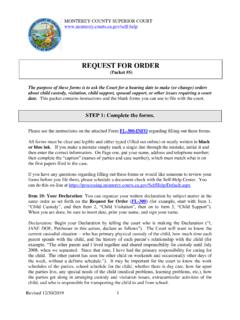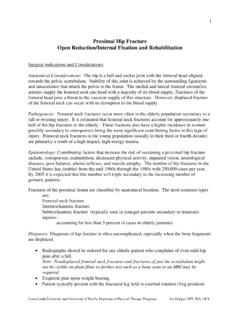Transcription of THE CANADIAN TRIAGE AND ACUITY SCALE
1 The CANADIAN TRIAGE and ACUITY SCALE : Education ManualVersion , 2012 CTAS National Working Group CANADIAN Association of Emergency PhysiciansModule 11 Course origins and role of assessment standards of emergency CEDIS Presenting Complaint patient care using understanding of ED processesLevel 1 - ResuscitationLevel 2 -EmergentLevel 3 -UrgentLevel 4 -Less UrgentLevel 5 -Non-UrgentCTAS Five Level TriageModule 1 Fundamentals of TriageModule One Objectives Historical basis of TRIAGE Purpose and value of TRIAGE Unique nature of emergency patients Professional role and personal characteristics of the TRIAGE nurse TRIAGE nursing skills TRIAGE processEvolution of TRIAGE Military roots Introduced to hospitals in early 1960s
2 Number of cases increasing People with non-urgent conditions come to EDs for treatment Initially, a 3-level TRIAGE (emergent, urgent, deferrable/non-urgent) was used In 1999, CTAS 5-level TRIAGE implementation guidelines published as recommended national guidelinesOrigins of CTAS National TRIAGE SCALE Australia ACEM 1994 CAEP TRIAGE and ACUITY SCALE Canada 1995 CTAS Canada (CAEP, NENA, AMUQ ) 1999 Paediatric CTAS (above + CPS, SRPC) 2001 Adult CTAS revision 2004 CEDIS Complaint list (+ revision) 2003 & 2008 Adult CTAS revision2008 Paediatric CTAS revision2008 What is TRIAGE ?The National Emergency Nurses Affiliation s (2002) definition of TRIAGE is: a sorting processutilizing critical thinkingand a standardized set of guidelines in which an experienced RN assesses patients quickly upon their arrival in an ED to: Assess and determine severityof presenting problems Process patients into a TRIAGE category and streaming to an appropriate location Determine access to appropriate treatment Effectively and efficiently assign appropriate human health resources.
3 A national standard for TRIAGE Improved patient care Increased TRIAGE reliability and validity Site & personal performance indicators National benchmarksRationale for the Development of CTASThe Benefits of TRIAGE Ensures critically ill or injured receive priority attention Establishes ACUITY and anticipates resources needed Predicts how long the patient can safely wait Supports effective utilization of space and resources Supports surveillance Improves communication and public relationsAvoiding TRIAGE as Access Block Streaming Lean processing (six sigma) to improve ED efficiencies is being broadly implemented One goal is shortening the time from arrival to emergency physician Streaming patients directly to the most appropriate place in the ED is key to success This can be accomplished by rapidtriage 1stor triaging the patient after directing them to an appropriate area Typical ED design changes include internal waiting rooms, limiting stretcher time to patients who don t need them, and rapid assessment zones Triaging with Overcrowding TRIAGE Drift Concept of normalization toward the mean The knowledge that a patient will need to be assigned to the waiting room.
4 May lead the TRIAGE nurse to uptriage a CTAS 4 or 5 patient in the hopes of shortening their wait Similarly there may be subconscious pressure to downtriage certain patients based on ED space limitations For example a patient may be assigned a CTAS 3 rather than CTAS 2 score feeling it unacceptable to assign level 2 patients in the waiting room A CTAS 3 patient may also be downtriaged to CTAS 4 to make them more appropriate for fast Patients are Unique Unscheduled/episodic Anxious and distressed Patient and care providers are strangers Patients experience symptoms/not a diagnosis Span all ages and types of emergencies Often lack primary careEmergency Patients are Unique Not all patients are as well as they appear and not all patients are as sick as they think.
5 What are your thoughts on that statement?What are some unique characteristics?Role of TRIAGE patients and determining with health treatment treatment protocols/first aid and in patient NursingWhat makes a good TRIAGE nurse? Personal traits Cognitive characteristics Behavioral characteristicsPersonal Traits Flexibility Autonomy Effective communication skills Assertiveness Patience Compassion Willingness to listen and learnCognitive Characteristics Diverse knowledge base Knows when not to act Uses critical thinking Able to make decisions quickly Able to prioritizeBehavioural Characteristics A patient advocate Works well under pressure Organized Able to improvise Applies intuition Confidence in judgment Trust in/reliance on peersTriage Nursing Skills Public Relations Interviewing Critical Thinking CommunicationSelf-AssessmentAssessmentCh aracteristicsMy Strong CharacteristicsAreas Needing
6 WorkPersonal TraitsCognitive CharacteristicsBehavioural CharacteristicsThe Process of TRIAGE Patient arrives ( critical look ) Screened for infectious disease TRIAGE assessment conducted Presenting Complaint (CEDIS) documented Modifiers considered TRIAGE Level assigned (CTAS) Assigned to waiting/treatment area Symptom relief provided or nursing protocols initiated Waiting patients reassessedPatient Arrival A variable % of patients arrive by ambulance. Their ACUITY ranges across all TRIAGE levels More patients arrive by other means of transport (known as walk-ins ). Their ACUITY also include all levelsCritical Look Critical first look across-the-room begins as soon as the patient arrives in the ED Perform a quick check ofA: AirwayB: Breathing C: CirculationD.
7 Disability (neurological) Should take 3 to 5 seconds Take action as indicatedCRITICAL LOOKINFECTIONCONTROLPRESENTINGCOMPLAINT1 stORDERMODIFIERS2ndORDERMODIFIERSI nfection Control Screening Screening requirements vary by region If positive (eg ILI, FRI), appropriate protective measures (respiratory etiquette, hand washing, isolation) need to be taken Use latest information available (from provincial, state, or national guidelines)CRITICAL LOOKINFECTIONCONTROLPRESENTINGCOMPLAINT1 stORDERMODIFIERS2ndORDERMODIFIERSS ubjective AssessmentThe story in the patient s own words: Their account of why they came to the hospital The symptoms they are experiencing Pain severity The injury history (mechanism of injury) Their concernsSelecting Presenting Complaint(CEDIS) Patient driven What concern brought you to the ED today?
8 Headache, Cough, SOB, etc. Which of the complaints bothers you most? My fever and shaking chills! Nurse driven Patient complains of leg swelling & moderate thigh pain, but nurse note moderate SOB. Could choose SOB or Lower extremity painCRITICAL LOOKINFECTIONCONTROLPRESENTINGCOMPLAINT1 stORDERMODIFIERS2ndORDERMODIFIERSO bjective AssessmentDraws on observable indicators (signs): Wounds, rashes, bleeding, cough, etc. Vital signs Reaction to pain Other indicatorsCRITICAL LOOKINFECTIONCONTROLPRESENTINGCOMPLAINT1 stORDERMODIFIERS2ndORDERMODIFIERST riage DecisionBased on the critical look, chief complaint, subjective and objective assessments, application of modifiers as required, then decide:What is the patient s priority?
9 TRIAGE Documentation Patient Name / Age Date and time Presenting Complaint (CEDIS) Subjective Assessment Objective Assessment 1st & 2nd Order Modifiers CTAS Level TRIAGE Nurse ID Allergies/Medications Immunizations Relevant Past History Interventions at TRIAGE Disposition ReassessmentWhen Line-ups Form Scan for critically ill patients and move them to the front of the line Anticipate re-prioritization Know the status of available treatment areas Stay calm, request help when requiredThe goal is to TRIAGE patients within10 to 15 minutes of arrivalPatients in the Waiting Room The number of patients waiting and their wait times have been increasing. Advise patient to return to TRIAGE desk if condition changes Depending upon hospital/site policies and medical directives, TRIAGE nurse may need to: Initiate diagnostics Provide symptom relief Dispense analgesics If numbers are overwhelming, call for assistancePatients in the Waiting Room How do you set priorities for treatment bed/physician assessment when you have five CTAS Level 3 patients waiting?
10 How long can this patient safely wait?Patient Reassessment GuidelinesLevel 1 Continuous nursing careLevel 2 Every 15 minutesLevel 3 Every 30 minutesLevel 4 Every 60 minutesLevel 5 Every 120 minutesNever change the initial TRIAGE document ACUITY level changes & change priority accordinglyAlways document reassessment One - ReviewQuestions?References1. Beveridge R, Clarke B, Janes L, Savage N, Thompson J, Dodd G et al. CANADIAN Emergency Department TRIAGE and ACUITY SCALE : implementation guidelines. Can J Emerg Med 1999; 1(suppl) R. CAEP Issues. The CANADIAN TRIAGE and ACUITY SCALE : a new and critical element in health care reform. CANADIAN Association of Emergency Physicians.





